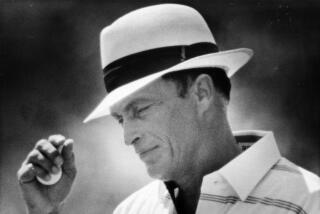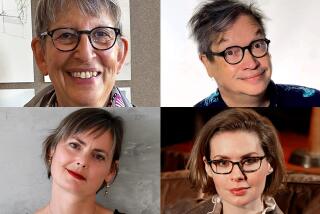Book review: ‘Charlie Chan: The Untold Story of the Honorable Detective and His Rendezvous With American History’ by Yunte Huang
- Share via
Charlie Chan
The Untold Story of the Honorable Detective and His Rendezvous With American History
Yunte Huang
W.W. Norton: 288 pp., $26.95
Charlie Chan, the wise and strategically polite Chinese detective given to pseudo-Confucian aphorisms, came to life on the pages of six popular novels and flourished in a remarkable run of 47 Hollywood movies. Yet the full story of Charlie Chan’s genesis and the adoration and outrage the Honolulu sleuth has aroused has never been fully told nor vigorously deconstructed until now. Yunte Huang has investigated this controversial cultural icon, reclaiming all things Chan in an involving, groundbreaking and far-reaching inquiry, the spirit of which is neatly captured by this “Chanism”: “Mind, like parachute, only function when open.”
Huang’s “Charlie Chan: The Untold Story of the Honorable Detective and His Rendezvous With American History” is a scintillating, provocative work of discovery, a voyage into racial stereotyping and the humanizing force of storytelling. It is also a deeply personal book in which Huang draws on his own upbringing in China and the questions of race and identity that he continues to consider today as an English professor at UC Santa Barbara.
Charlie Chan, Huang tells us, was the unlikely creation of Earl Derr Biggers, a small-town kid from Ohio who made his way to Harvard as did Huang nearly 100 years later, albeit as an assistant professor. After growing up in southeastern China, Huang was studying English at Peking University when he joined the 1989 student protests for democracy. If his anxious family hadn’t tricked him into coming home, Huang would have been in Tiananmen Square during the government massacre. Instead, he came to the U.S. to resume his studies and first encountered Charlie Chan while book hunting at an estate sale. He bought and read Biggers’ novels, promptly became “an avid fan” and soon embarked on what he describes as “increasingly obsessive research.”
Huang anchors his exploration in a vivid panorama of late-19th century Hawaii, where ambitious American traders were systematically exploiting the islands’ resources and dismantling the ruling monarchy. As plantations expanded, cattle and horses were introduced and Chinese carpenters, merchants and laborers arrived, among them the father of a boy who eventually called himself Chang Apana. Poor and illiterate, Apana became a superb horseman and found work as a paniolo, or cowboy, on the ranch of a prominent family with New England roots, the Wilders. When Helen Wilder founded Hawaii’s chapter of the Humane Society in 1897, she asked Apana to serve as the islands’ first animal-protection officer.
This may sound like a cushy gig, but animal rights were a hard sell in booming, horse-powered, roughneck Honolulu, and Apana’s natural authority, strength and quick-mindedness were routinely put to the test. So highly respected and renowned did Apana become that the Honolulu Police Department recruited him as soon as Hawaii became a U.S. territory in 1898. Assigned to Chinatown’s “labyrinthine underworld,” Apana morphed into a “supercop,” nimbly scaling walls, sneaking into gambling and opium dens, surviving vicious attacks, becoming a master of disguise and solving the city’s most daunting cases.
Huang, who clearly relishes every biographical detail, could find no evidence proving that Biggers knew about Apana when he created Charlie Chan as a minor character in his first book, “The House Without a Key” (1925). Much to Biggers’ surprise, the Honolulu detective was a huge hit with readers. Biggers increasingly gave cunning and witty Chan top billing and at some point looked to Apana’s exploits to fuel his bestselling series. But Biggers brought more than action to his crime novels, as Huang explains: “Biggers seemed to have an uncanny ability to imagine the complexity of being a Chinese law enforcer in a multiracial society like Honolulu around the turn of the century.” Biggers and Apana did meet in 1928, and Apana got a kick out of being known as the real-life Charlie Chan, happily autographing copies of Biggers’ books, even though he couldn’t read them. Apana also met Warner Oland, the actor who played Chan in more than a dozen now-classic 1930s Charlie Chan movies. A Swede with Slavic blood on his mother’s side, Oland basically portrayed a Chinese man in yellowface.
And herein lies some of the trouble with Chan.
In parsing this casting choice, Huang looks to America’s minstrel tradition, in which white men performed in blackface. Such racial parody and ventriloquism enabled whites to “act out and solidify their whiteness” in a theatrical conquest. Huang considers the practice of yellowface in light of the persistent post-Civil War economic depression, during which out-of-work Americans blamed Chinese immigrant workers for stealing their jobs. In 1882, Congress passed an immigration bill known as the Chinese Exclusion Act, which cut off Chinese immigration and denied Chinese individuals American citizenship. (We now find ourselves in yet another economic crisis amplified by racist talk and new laws aimed at yet another immigrant group.)
After interpreting a rich bounty of rarely examined material, and carefully sorting through pro and con responses to Chan over the decades (Huang places Chan beside Sherlock Holmes, Philip Marlowe and Hercule Poirot), Huang reminds us that Charlie Chan is complicated, unruly, chimerical, possibly mythic and certainly politically incorrect. With his brilliant and hilarious Chanisms and subtle ways, the honorable detective, Huang declares, is a trickster and a folk hero, a classic embodiment of grace under pressure in which one fights oppression by camouflaging one’s power and intent with humor and mock humility.
Surely Charlie Chan would concur and offer this affirmation: “Truth, like football, receive many kicks before reaching goal.”
Seaman is an associate editor of Booklist, book critic for Chicago Public Radio and author of “Writers on the Air: Conversations About Books.”
More to Read
Sign up for our Book Club newsletter
Get the latest news, events and more from the Los Angeles Times Book Club, and help us get L.A. reading and talking.
You may occasionally receive promotional content from the Los Angeles Times.






